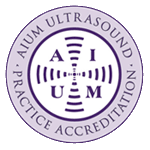
Ultrasound, or sonography, uses sound waves to obtain images of the baby, uterus, placenta and cervix.
Ultrasound is very different from X-rays, which involve radiation and have hazards for the pregnancy. The ultrasound technology which we use to obtain pictures and measurements of your baby is similar to that used by bats to “see in the dark” and by whales and dolphins to locate objects under water and to find fish. There have been numerous studies to determine whether ultrasound has adverse effects on pregnancy. The studies to date have shown an excellent safety profile for ultrasound performed for prenatal assessment of the baby.
Ultrasound examination of the pregnancy is truly our window on the womb. Ultrasound can be used for a variety of purposes during pregnancy – to check the location of a pregnancy, assess the due date and the growth of the baby, and evaluate the embryo/fetus for abnormalities. Newer, specialized studies are important adjuncts to care for women who have certain pregnancy complications such as high blood pressure or isoimmunization, or who have had problems with preterm labor.
The sonograms at our center are performed by experienced perinatal sonographers and obstetricians with sub-specialty training in maternal-fetal medicine. Our office performs about 9,000 sonograms a year, has experience with the diagnosis of thousands of congenital abnormalities, and has achieved accreditation by the AIUM and certification as a Prenatal Diagnostic Center by the state of California.
Early in the Pregnancy
Between five and about 11 weeks into the pregnancy, the primary use of ultrasound is to make certain that the pregnancy is within the uterus rather than outside the uterus (ectopic pregnancy), to make certain that the mother is carrying one baby rather than twins or triplets, and to confirm the due date for the pregnancy. Ultrasound done at this stage is very accurate in assessing the due date – the measurements of the baby should be within seven days of mom’s pregnancy dating based on her last cycle, or on when she believes that she ovulated. If there is more than a seven day discrepancy, then the ultrasound is used to assign the due date.
Ultrasound is very helpful in evaluating women who have lower abdominal pain or bleeding during the pregnancy. When women have cramping and bleeding early in the pregnancy and are threatening to miscarry, ultrasound can be used to make sure that the pregnancy is still safe within the uterus, and can be used to diagnose different stages of miscarriage as well. Lower abdominal pain can come from tubal (ectopic) and sometimes occurs in women with ovarian cysts and with uterine fibroids.
Two of the most important sonograms during any pregnancy are the nuchal translucency sonogram and the genetic sonogram.
After 22 Weeks
Ultrasound examinations can be done throughout the pregnancy. After 22 weeks, we can check for the same structures as we can at the time of the genetic sonogram – including the developing baby, the uterus, the placenta, the cervix and the ovaries.
Ultrasound at this stage in the pregnancy is less accurate than earlier sonography for determining the due date. Between 22 and 26 weeks, the ultrasound should match the due date within two weeks, and after 26 weeks, within three weeks. The reason for this is that most of the variation in the growth of babies happens in the third trimester of pregnancy. For example, a baby who will ultimately be born at full term weighing 5½ pounds will have the same measurements at 20 weeks as a baby who will ultimately weigh 10 pounds!
When we identify a baby who is growing too rapidly for stage in pregnancy, then we worry about mother having elevated blood sugars, or diabetes. This can be checked via blood testing. If we identify a baby who is growing too slowly, then we can sometimes identify a means to help the baby grow better, such as control of a maternal condition like asthma, and we can also recommend means for assessing ongoing growth and good health of the baby for birth.
Ultrasound later in the pregnancy can also be used to recheck the baby for anatomic structures that were not seen clearly earlier on. This is particularly important in pregnancies where a prior baby in the family had a late developing birth defect, such as hydrocephalus.
